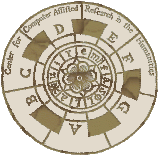CCARH Publications
Row Forms in the Serial Works of Schoenberg, Berg, and Webern
Encoded by
Justin
London, Paul von Hippel,
David
Huron, Jonas Cartano, Kate Kingery, Bess Olsen, and Tami Santelli.
Edited, error-checked, and translated to Humdrum format by Paul
von Hippel , 2000/2001. |
 |
From the README
file:
ROW FORMS IN THE SERIAL WORKS OF SCHOENBERG, BERG, AND WEBERN
encoded by Justin London, Paul von Hippel, David Huron, Jonas Cartano,
Kate Kingery, Bess Olsen, and Tami Santelli
edited, error-checked, and translated to Humdrum format by Paul von
Hippel
These files represent tone rows used in the serial works of Schoenberg,
Berg, and Webern. Students and scholars may find these files a useful resource
in their study of these works.
Data were encoded from three paper sources. Rows by Schoenberg were
encoded from an unpublished compilation prepared by Paul Metz in the early
1980s. Rows by Webern were encoded from those given in Kathryn Bailey's
*The Twelve-Note Music of Anton Webern* (Cambridge University Press, 1991).
Rows by Berg were encoded from Dave Headlam's *The Music of Alban Berg*
(New Haven, CT: Yale University Press, 1996). The inclusion of certain
rows by Berg may be debated. In Wozzeck and the Chamber Concerto, it has
been argued that Berg treats his rows as 12-tone "themes;" and in the Lyric
Suite, as in Lulu, all the rows are related to a common source row (though
the relationships can be quite indirect). Scholars wishing to ensure an
independent sample of proper tone rows may wish to restrict their attention
to part of the Berg database; we have left this decision to the discretion
of individual researchers.
All data are encoded in the Humdrum format (www.humdrum.org). Each file
begins with reference records identifying the composer, work, date, and
sometimes additional information. Each file continues with two parallel
spines:
(1) a **pc spine representing the row in integer notation, with
the first note of the row as 0
(2) a **kern spine representing the prime form using note names
in the octave below middle C
(Note that the **kern spine usually begins with a note other than C
-- i.e., other than 0 in pc notation. When converted using the Humdrum
"pc" tool, the **kern spine will therefore differ from the **pc spine by
a fixed transposition.)
In addition to the usual Humdrum reference records, several special
reference records were developed for this database:
!!!AIR: Indicates an all-interval row.
!!!DRV: Indicates that the row can be "derived" by transformations
of its first 2, 3, 4, or 6 notes.
!!!IHC: Indicates that the row is inversionally hexachordally
combinatorial.
!!!MIR: Indicates a mirror row, and describes how it can be
transformed into itself.
!!!RKY: Reports a standardized score of the row's key or tonal
implications.
A positive score suggests that the row has strong tonal implications; a
negative score suggests that the row seems to avoid tonal implications.
(The scoring method was developed by Paul von Hippel and David Huron in
an unpublished paper.)
!!!SEM: Reports the row's number of semitone interval classes.
!!!T33 and !!!T35: Reports the row's number of 3-3 and 3-5 trichords.
(Only non-overlapping trichords are considered.)
The database has been subjected to visual inspection and a number of
automatic error checks, leading to the correction of over a dozen errors.
Specifically, the error checks verified that
(1) each row represents exactly 12 distinct tones;
(2) each row contains no invalid signifiers such as a pitch class
integer (**pc value) of 19;
(3) each file is in valid Humdrum format;
(4) in each file, the integer representation (**pc) is consistent
with the note-name representation (**kern);
(5) the rows display symmetries and relationships remarked by
scholars;
In addition, 68 of the rows (schoenberg01-42, webern03-21, berg02,04,05,09,10,17,23)
were encoded twice -- once by note name, and once by pc integer. Errors
were then corrected by resolving discrepancies between the two encodings.
The 42 rows by Schoenberg were encoded a third time, by a different encoder
using a different strategy. Comparison against this third encoding revealed
no errors that had not been uncovered earlier -- suggesting that there
are few if any errors error rate in the double-entered files. Errors remaining
in the database are likely to be concentrated in the newest files, which
were not double-entered (webern01-02, berg01,03,07,08,11-16,18-22). If
you find an error or oversight, please report it to Paul von Hippel (von-hippel.1@ohio-state.edu).
Scholars using this database should cite it as follows:
London, J., von Hippel, P., Huron, D., Cartano, J., Kingery, K.,
Olsen, B., & Santelli, T. (2000/2001). (von Hippel, P., ed.). Row forms
in the serial works of Schoenberg, Berg, and Webern. [Computer database.]
Stanford, CA: Center for Computer Assisted Research in the Humanities (www.ccarh.org/publications/data/humdrum/tonerow/).
Further information and a precursor to this database are available at
www.carleton.edu/curricular/MUSC/resources/2ndviennese.htm.

 Individual
tonerows (last updated 24 June 2002)
Individual
tonerows (last updated 24 June 2002)